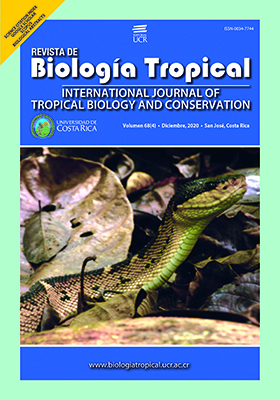Resumen
Introducción: El Pacífico Norte de Costa Rica generalmente se considera rico en hábitats y especies marinas. Sin embargo, algunas zonas están sujetas a presiones de pesca que pueden degradar los ecosistemas. El Golfo de Papagayo comprende zonas protegidas y desprotegidas con diversos grados de impacto. Objetivos: Nuestro objetivo fue evaluar el estado de conservación de las comunidades de peces e invertebrados en los arrecifes rocosos y las zonas arenosas de dos bahías desprotegidas del Golfo de Papagayo. Métodos: El estudio se llevó a cabo en las bahías de Cabuyal y Zapotillal, al sur del Parque Nacional Santa Rosa. Desde diciembre 2017 hasta abril 2018, se realizaron un total de 35 transectos paralelos a la costa entre 3-10 m de profundidad. Se identificaron especies de peces e invertebrados y se estimó la biomasa por grupo trófico en los peces, y la densidad en los invertebrados. Resultados: Encontramos un alto número de especies de peces (81) e invertebrados (70) en arrecifes rocosos, lo que indica un ecosistema biodiverso, pero pocas especies de peces en zonas arenosas. La composición de especies difirió entre las dos bahías. La densidad de peces juveniles fue elevada en la bahía de Zapotillal, lo que sugiere que la zona podría ser importante para el reclutamiento y la reproducción. La biomasa de peces fue mayor en zonas arenosas que en arrecifes rocosos y todos los grupos tróficos tuvieron menores biomasas que en otras zonas desprotegidas de la región. En promedio, la biomasa de peces de arrecifes fue de 1.57 ± 0.67 (s.e.) t ha-1, similar a lo reportado anteriormente en el Pacífico Norte de Costa Rica. Por grupo trófico, los piscívoros y planctívoros tuvieron la biomasa más alta en las zonas arenosas y los piscívoros y carnívoros en los arrecifes rocosos. La cobertura media de coral fue baja con 4.09 % ± 2.51 (s.e.), similar a la reportada anteriormente para la región. Conclusiones: Las bahías Cabuyal y Zapotillal en el Golfo de Papagayo son biodiversas en peces e invertebrados. Sin embargo, la zona puede verse afectada por las pesquerías locales y otras actividades humanas, lo que afecta a las poblaciones de peces e invertebrados y formaciones coralinas. Nuestro estudio llena algunos vacíos de conocimiento de la biodiversidad marina en el Golfo de Papagayo que pueden contribuir a la conservación de la vida marina en el Pacífico Norte de Costa Rica.
##plugins.facebook.comentarios##

Esta obra está bajo una licencia internacional Creative Commons Atribución 4.0.
Derechos de autor 2020 Keilor Enrique Cordero Umaña, Cordero-Umaña, K., Pilár Santidrián Tomillo, Santidrián Tomillo, P.



